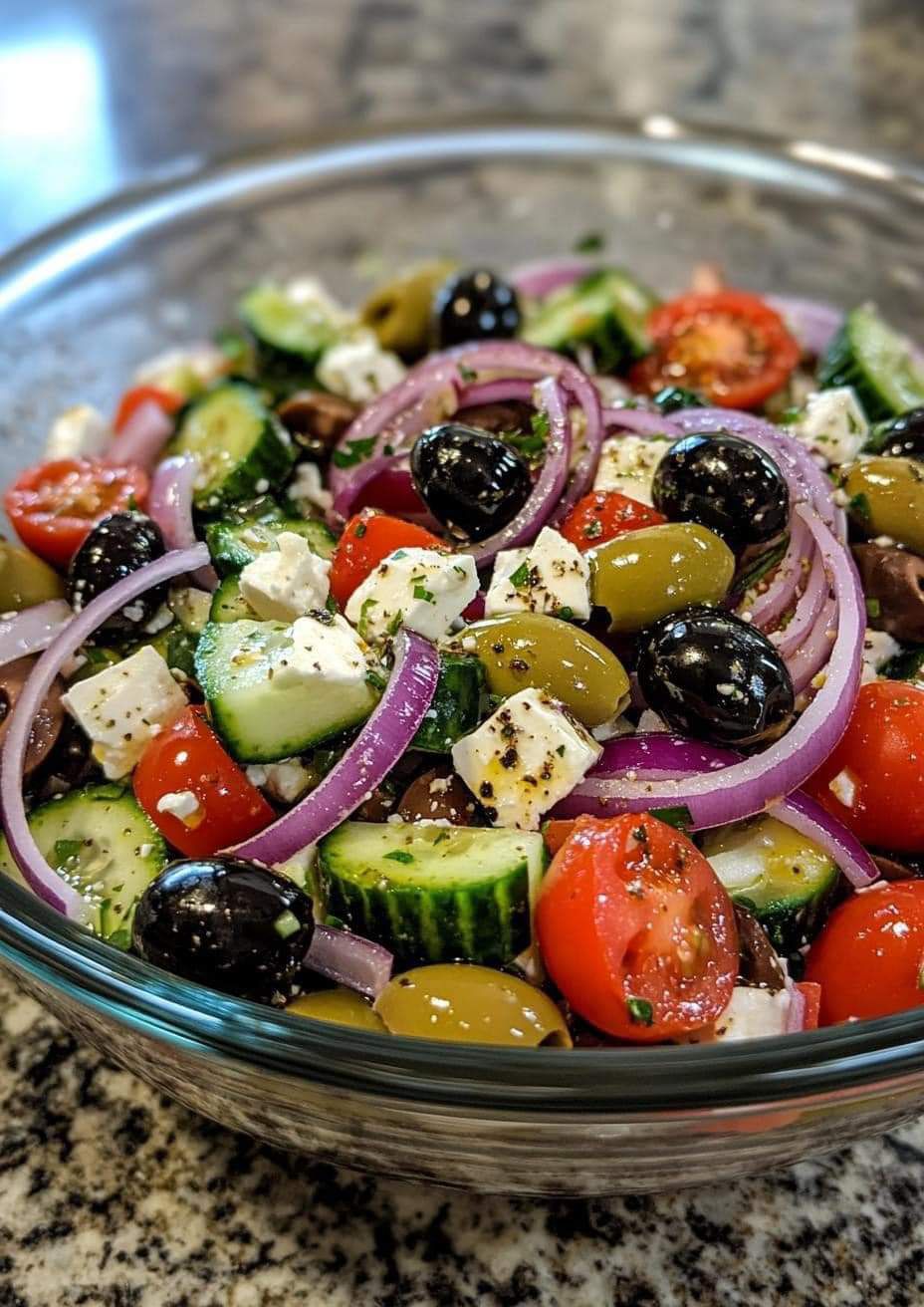Step 1: Prepare the Vegetables
Start by washing and cutting all the vegetables. Slice the tomatoes into wedges or bite-sized chunks, depending on your preference. Peel and slice the cucumber into rounds (you can leave the skin on if you like the extra crunch). Thinly slice the red onion and green bell pepper into rings or strips.
Step 2: Arrange the Salad
In a large serving bowl or platter, arrange the tomatoes, cucumber slices, onion, bell pepper, and Kalamata olives. Greek salads are traditionally served in a casual, rustic style, so no need to be overly precise. Place the cubes of feta cheese on top of the salad. For an authentic presentation, leave the feta in larger chunks rather than crumbling it.
Step 3: Make the Dressing
In a small bowl, whisk together the olive oil, red wine vinegar, lemon juice, minced garlic (if using), and a pinch of salt. Taste the dressing and adjust the seasoning as needed.
Step 4: Dress and Season the Salad
Drizzle the olive oil dressing over the salad, making sure to coat the vegetables and feta evenly. Sprinkle the salad generously with dried oregano, and season with a little salt and freshly ground black pepper to taste. Keep in mind that both the olives and feta are salty, so you may not need much additional salt.
Step 5: Serve and Enjoy
Greek salad is best enjoyed immediately after it’s made, while the vegetables are crisp and fresh. Serve it as a refreshing side dish with grilled meats like souvlaki or gyros, or as a light main dish with a piece of warm pita bread.
Tips for the Best Greek Salad
- Use the freshest ingredients: Since this salad relies on the natural flavors of the vegetables, make sure your tomatoes, cucumbers, and peppers are at their peak.
- Authentic Greek feta: Try to find a good-quality Greek feta made from sheep’s milk. It has a tangy, rich flavor and crumbly texture that is irreplaceable.
- Dress the salad just before serving: To keep the vegetables from getting soggy, add the dressing right before you’re ready to eat.
Variations to Try
- Add some protein: For a heartier version, add grilled chicken or shrimp on top of your salad.
- Swap the bell pepper: If you’re not a fan of green bell peppers, feel free to use red, yellow, or orange for a sweeter taste.
- Make it a meal: Serve the salad with warm pita bread or alongside a spread of tzatziki and hummus for a complete Mediterranean feast.
The Perfect Pairings
Pair this refreshing Greek salad with:
- Grilled lamb or chicken skewers: A classic match for the bold flavors of this salad.
- Spanakopita: Greek spinach pie pairs beautifully with the light, crisp vegetables.
- Roasted potatoes: Serve with crispy, lemony roasted potatoes for a complete Mediterranean meal.
Health Benefits of Greek Salad
This classic salad isn’t just delicious—it’s incredibly healthy too! Packed with fresh vegetables, heart-healthy olive oil, and antioxidant-rich tomatoes and olives, Greek salad provides a variety of nutrients:
- Tomatoes are a great source of vitamins C and K, as well as antioxidants like lycopene.
- Cucumbers provide hydration and are low in calories, making this a great dish for weight management.
- Olive oil contains healthy monounsaturated fats that can reduce inflammation and improve heart health.
- Feta cheese, although salty, is rich in calcium and protein, contributing to strong bones and muscle health.
Conclusion: A Taste of the Mediterranean at Home
The simplicity of a Classic Greek Salad allows the quality of the ingredients to shine through. It’s a dish that transports you to the sun-drenched Greek islands with every bite. Whether you’re serving it as a starter, a side, or even as a light lunch, this salad is sure to refresh and satisfy.
Make it today and bring a little taste of Greece into your kitchen—enjoy!
